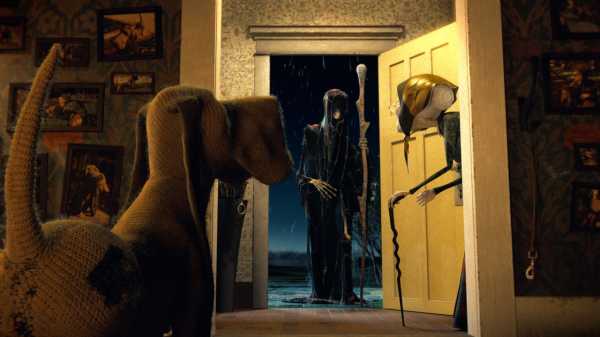
“It’s a medium where you can do literally anything,” Bailey said, of C.G.I.
It was a dark and stormy night when an old woman opened her door to a stranger. The first scene of the short animated film “Death and the Lady,” directed by Geoff Bailey and Lucy York Struever, uses this cliché—one that has been denounced, resurrected, and satirized by authors for nearly two centuries. The husband-and-wife duo told me that “fighting versus accepting” such storytelling tropes is a central conceit of the film.
The film begins with sound: a patter of rain, a crash of thunder. A scene of comfort emerges in which a woman sits, knitting, in a living room illuminated with warm lamplight, walls filled from floor to ceiling with picture frames. The melancholic French song “Les Feuilles Mortes,” or “Autumn Leaves,” plays on a gramophone.The room evokes the hazy ambience of history: the photographs appear blurred in the background, but the directors imagined and curated every memory for the woman and her dog, Jackson, who soon proves to be a central character. “We built a whole life for them,” Bailey said, in which the lady and Jackson picnic, play Frisbee, and embark on coastal vacations, but “we don’t expect you to zoom in,” Struever noted. Even if it’s not consciously noticed, the accumulation of detail establishes the homely atmosphere.
“Death and the Lady” is fully animated with computer-generated imagery; Bailey taught himself the techniques. “It’s a medium where you can do literally anything,” Bailey said, of C.G.I. “And yet we still have so many films that look very similar.” For the directors, the sameness of many C.G.I. films is a “pet peeve,” and their film attempts to push the boundaries of the technology, by working with objects and staging processes that they might have used in real life. This is evident in the textures: the lady’s face is composed of papier-mâché newspapers, the dog is woven from yarn, and all of the wallpapers are antique William Morris prints. “We wanted to imbue the house with a feeling of time,” Struever said.
The cozy scene is soon interrupted by a rapping on the door. The lady opens the door to Death, a rain-soaked figure cloaked in black, with two skeletal hands, one carrying an ivory staff. Jackson barks in alarm, but the lady exclaims, “You must be freezing, little one,” and invites Death in for a cup of tea. Later, in a Proustian flourish, she offers a madeleine. “That’s a very pretty poncho you have,” she remarks, oblivious to any danger. The closeness between Jackson and the lady becomes fractured by the intrusion, and the question of who or what Death will take haunts the rest of the film.
The concept behind “Death and the Lady” originated in Prospect Park. “We came up with the idea as we were walking our dog” years ago, Bailey said. “We had one dog. Now we have two dogs,” he added, and their canine companions provided voices and sound effects for the film. “I think the more time you spend with animals, the more you realize how amazing, wondrous, and strange it is to share your life with an alien being that you can somehow communicate with,” he said. But the joy of a new addition to the family can also provoke fear of its future affliction or loss—and the film’s themes of loneliness and mortality became sharper, and felt closer to home, as the directors worked on production during the coronavirus pandemic.
The film has an ethereal quality. Bailey and Struever opted to use French dialogue instead of English, inspired by “old European fairy tales” and in order to construct a sense of distance with viewers. In a later scene, Death’s cloak glistens with rainbows, in a kind of “reverse prism,” Struever said, hinting at the promise of the afterworld. It was a technical challenge to fabricate something “that felt beautiful and otherworldly,” Bailey said. The result is a fresh approach to a traditional children’s fable, and a film punctuated by moments of action: a cat-and-dog rivalry, a ferocious tussle with death, and, finally, a glimpse of the world beyond life. ♦
Sourse: newyorker.com






